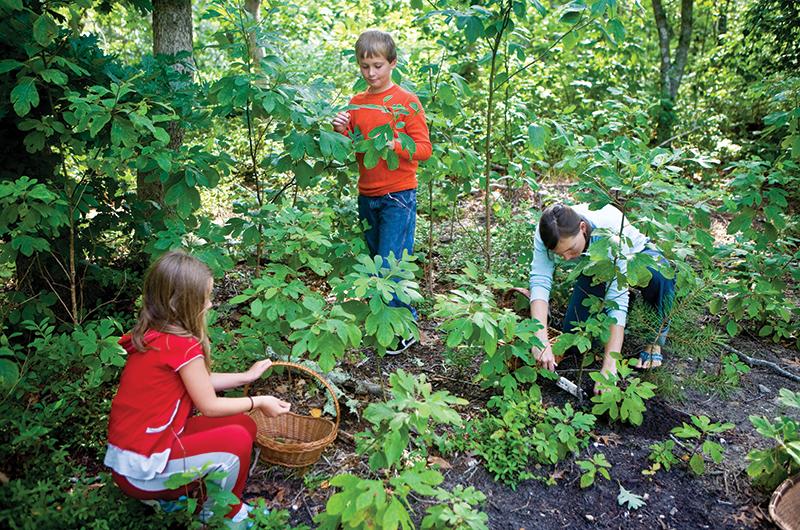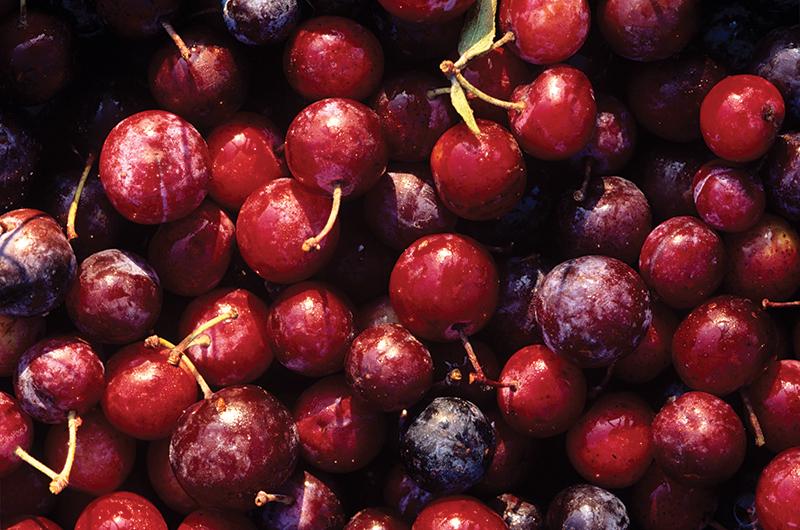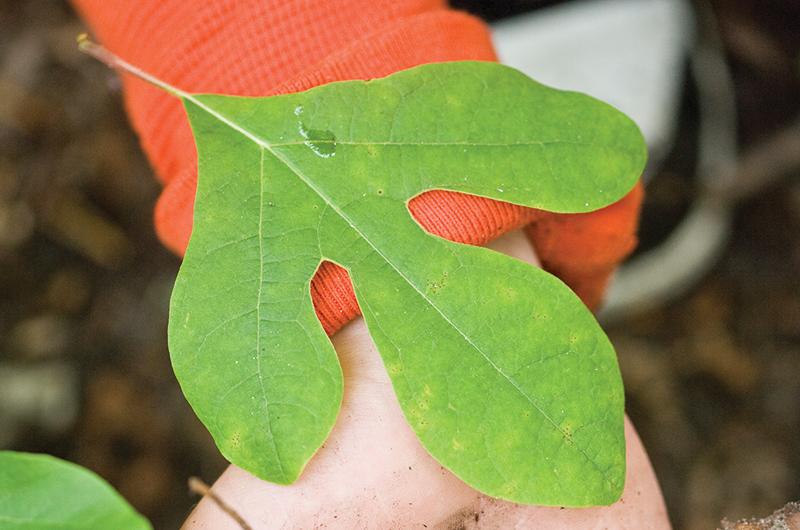
Now is the time to harvest the brilliant ripe fruits and seeds of autumn to put away for the winter. The Vineyard is home to many trees and shrubs that gift us with edibles such as nuts and leaves, and learning how to preserve them is well worth the effort. Bottles and jars of colorful fruits and syrups also make wonderful Island-made gifts for the holidays.
Beach plums

Along many a Vineyard beach, especially up-Island, you will find beach plum shrubs (Prunus maritima) with their shiny, oval leaves and fragrant, white blossoms. In the spring the plant flowers profusely, and by fall the small, firm fruits have turned purple. Many Islanders spend the autumn making juices and wines from the fruits, but most people rave about the jelly (some say jam) that they find from Ethel Sherman at the West Tisbury Farmer’s Market if they arrive early enough. With a tartness similar to rose hips, beach plums offer the epitome of a Vineyard delicacy.
Black chokeberry
Despite their unfortunate name – they will not make you choke – these delicious berries are edible and worth the search in the woods of the Island. They are similar to a handful of other plants, including huckleberry and chokecherry, which makes accurate identification the work of professional botanists. Nevertheless, chokeberry and similar species are edible, so this should not hinder you from exploring the woods with a bucket and an appetite. The black chokeberry (Photinia melanocarpa) is a shrub growing two to six feet high in thickets, dry or wet acidic soils, bogs, and swampy woods – the same places you find blueberry bushes. Slender, thornless stems support leaves that are oval, lightly toothed, and hairless underneath (red chokeberries display hair under the leaves); the flowers are white to pink hanging in bells. The fruit, which first appears in August, is shiny, black, and perfectly round, growing not as grapes do down the length of a stem, but rather in a loose flat-topped cluster of six to eight near the leaf joints. Look for chokeberries whenever you go blueberry picking as the fruits appear at the same time and grow in the same environment. Historically the Wampanoags used these nutritious berries fresh as well as dried in winter, adding them to stews as thickeners. Bring a basket or a few gallon bags with you to harvest a large amount. Wash them gently and drain, then use them as you would blueberries: Sprinkle onto oatmeal or cornmeal pancakes, or mix with blueberries, raspberries, and sliced grapes and top with a dollop of whipped cream.
Elderberry
Elderberry (Sambucus canadensis) is one of the most ancient and useful shrubs, with great mythology and folklore to its credit – for example, it’s been said if you sit under an elder bush on a midsummer’s eve, a fairy will appear. Its fragrant blossoms are an excellent, traditional herbal remedy for treating children’s fevers. Look for the tall, broad shrubs anywhere you see creeks, bogs, marshes, or ponds; they won’t be in the water, but they’ll be nearby. Elder likes to keep its toes wet. The leaves are ovate, long, and resemble cherry tree leaves; the flowers are white, lacy, and form in a broad, thick umbel at the end of the slender branches. Dry a few of the flowers and store them in an airtight container, and wait for the rest to swell up into juicy, dark purple fruit. (The leaves, roots, and bark should never be eaten.) Elder flowers have been used successfully in syrups, teas, and tinctures to treat hay fever, sinusitis, and any catarrhal inflammation of the upper respiratory tract. Elderberry fruit is high in fruit sugars (including flavonoids) and acids, tannin, and vitamin C and is useful in treating rheumatism and prized as a remedy for children’s coughs and fevers. The berries can be cooked as you would blueberries into pies and muffins.
Goldenrod
Martha’s Vineyard is home to native goldenrod (Solidago Spp.), easily recognized by its tall, graceful, yellow plumes. There are many species, most of which can be used interchangeably, though the flowers and leaves of one – sweet goldenrod (Solidago odora) – are used mostly to brew a delicious beverage. The tea made from this plant, whose crushed leaves smell like anise, was named Liberty Tea after the Boston Tea Party, because it could be made without relying on black tea from Britain, and it became the beverage of choice among people hard pressed to do without their steaming morning cup. Here on the Island, we can harvest the leaves and flowers for this so-called Blue Mountain Tea (another affectionate name for goldenrod tea), as well as for external applications on wounds in the form of a traditional compress.
Grapes and grape leaves
One of the most preeminent of the wild edibles on Martha’s Vineyard is, of course, the wild grape. Growing all over the Island, it’s easily identified – with its large prominent, maple-like leaves growing in vines and fragrant bunches of small, purple grapes perfuming the fall Vineyard air.
Legend has it Bartholomew Gosnold took note of the abundance of wild grapes in the naming of the Island for his daughter after he landed here in 1602. But long before the first Europeans landed here, native Islanders, Wampanoags, had been well versed in the uses of this wild edible, using the fresh fruit and drying it with other berries for use in the winter. The Island grapes are mostly fox grapes (Vitis labrusca), one of some forty-plus varieties native to North America growing along the East Coast from Maine to South Carolina. Fox grapes are smaller than cultivated grapes and have a slightly tart, musky
flavor that lends itself to a nice jelly, but not so much to just eating off the vine.
The famous Concord grape is a cultivar of this V. labrusca variety that was first hybridized in Concord, Massachusetts, in the mid-nineteenth century. Primary uses for the fox grape on the Island include jams, jellies, and wine. The leaves are edible and useful as well, especially for stuffed grape leaves.
For this, pick earlier in the spring when the leaves are still tender but large, and drop into boiling water for ten to twenty seconds. Throughout the summer and fall, the large leaves can be gathered, rinsed, and used to line fruit and cheese platters – making for a beautiful presentation at any party.
Hazelnuts
Martha’s Vineyard boasts many secrets, among them hazelnut trees (Corylus americana). It can be helpful to scout out these delicacies in the summer, so that come autumn as the nuts mature, you get to them before the squirrels and raccoons do. Hazelnuts are ten- to fifteen-foot-tall shrubs with waxy, thick, dark green leaves and lighter green nut-pods. These pods generally hang beneath the leaves and form clusters of typically four nut-casings surrounded by smooth husk coverings that open at the bottom as the nuts mature. At maturity, the pods are almost as big as golf balls and the husks split open easily. You must pick them at or after maturity, though, because even large husks, if immature, will hold only tiny little nuts after the shell is cracked. These are the filberts or hazelnuts you find at the grocery store, but they grow so abundantly here they are worth experimenting with. Try adding them to a bread recipe, candying them, or even making a chocolate hazelnut liqueur.
Sassafras
After Christopher Columbus brought sassafras root to Europe, it was considered a fashionable remedy for just about anything and was used as a heal-all. It was listed in the London Pharmacopoeia in 1618, and in the U.S. Pharmacopoeia in 1820, but once it became a prominent remedy for syphilis, its popularity decreased. Bartholomew Gosnold began the exportation of sassafras (Sassafras albidum) from Martha’s Vineyard after he arrived in 1602, and it remained one of the Island’s chief industries for nearly a century. Easy to recognize, thanks to three distinct leaf-shapes growing on each tree (smooth elliptical, one-finger mitten, and two-finger mitten), sassafras saplings have thumb-width trunks and a reddish appearance about the leaves and stem. Mature sassafras on the Island can grow thirty to forty feet tall and make up a large portion of our woodlands. Sassafras leaves make a pleasant chew or tea, but the flavor of the root is much stronger. Treat yourself to an afternoon of finding a small (two-inch diameter) tree, dig down and follow the roots out laterally. You needn’t dig deep – just horizontally – and don’t lose those roots: That’s where the highest concentration of flavor is. Slice the roots, taking two to eight inches of the horizontal tuber, and leave the tree intact. Chop and brew the roots in boiling water for twenty minutes or longer, and strain. The flavor is sharp, fragrant, and stimulating.
The first two installments in this series are on our website, www.mvmagazine.com. They feature items in spring and summer that may grow throughout the season. For more information on traditional herbal medicines, visit www.vineyardherbs.com.

Wild foods weekend
Polly Hill Arboretum and Slow Food Martha’s Vineyard will host Russ Cohen, wild foods enthusiast and professional environmentalist, for a day devoted to the art of finding and preparing wild foods. The author of Wild Plants I Have Known…and Eaten (Essex County Greenbelt Association, 2004) has been leading wild food walks in the Boston area for more than thirty years.
On Saturday, September 26, Russ will guide participants on a daytime exploratory journey to forage for wild edible plants growing on the island of Chappaquiddick. As he identifies suitable plants, he will discuss what part is edible, when to harvest, and how to prepare, as well as safety factors and conservation. That evening, Russ will be a guest at a special Slow Food Fall Foraging Potluck, which is open to the public. This event will be held at the West Tisbury Ag Hall at 6:30 p.m. Everyone is invited to bring a dish with Island-grown, preferably wild, ingredients (seafood included).
Due to space limitations, call Polly Hill at 508-693-9426 to preregister for the walk. Participants need not sign up for the potluck; additional information is available from Cathy Walthers at 508-645-3820.
To start the weekend, Island chef and Slow Food member Jan Burhman will host an evening with Russ Cohen on Friday, September 25, from 4 to 8 p.m. as part of her Culinary Experiences program. With Russ as the guide, participants will forage up-Island and create a meal based on what they find. To sign up for this program, go to www.culinary-experiences.com.
Fun with food: Autumn olives
We’ve all grown up with the warning to avoid eating berries in the wild, and the fear of eating a red berry may be hard to overcome for some. But autumn olives, the tiny red fruit that hangs in heavy clusters from small trees all over the Island, is readily identifiable. They’re covered with tiny, white or silvery speckles, if you look closely.
Kids and adults alike love the slightly sweet, slightly tart taste of the juicy autumn olive, with a flavor similar to that of a pomegranate seed or dried cranberry. Mothers can love the fact that these berries, ounce for ounce, pack as much as seventeen times more lycopene than a tomato and contain high levels of the antioxidants vitamins A, C, and E, as well as flavonoids and essential fatty acids. The nutritional levels are so high, there is pharmaceutical interest in the use of autumn olives for heart-health protection and against certain cancers, like prostate.
Picking autumn olives on a warm fall day on the Vineyard ranks high on our list of pleasant outdoor activities. It’s a great excuse for a walk outside and one that may entice kids. You don’t need to bring a snack; it’s growing free on a tree.
Autumn olive (Elaeagnus umbellata) is not native to Martha’s Vineyard. The small tree or tall shrub with silvery blue leaves originated in Asia and was brought to the U.S. in the nineteenth century. In modern times, autumn olive trees were planted alongside highways to beautify and prevent erosion, because they thrive in adverse conditions. It is now considered an invasive species that can crowd out other plants, and since 2006 in Massachusetts it has been illegal to sell or replant. Luckily, there are no rules against foraging for the fruit. On the Island, you can find autumn olive trees along roads and driveways, and sometimes along paths through the woods.
The tartness of the berries, and even the size, can vary from tree to tree. The larger the berry, the sweeter it is. In addition to being eaten fresh, autumn olives can be added to salads, made into a sauce, consumed along with cheese, and turned into a jam or jelly.
But for kids, the optimal transformation for autumn olive is into fruit leather, a chewy snack – with a characteristic sweet-tart taste – that’s easy to make at home.
Autumn Olive Fruit Leather
Ethel Sherman’s Beach Plum Jelly
Holly’s Elderberry Syrup
Recipe for Banana-berry Muffins






